Influencing Factors and Theoretical Models for the Surface Topography in Diamond Turning Process: A Review
Abstract
1. Introduction
2. Theoretical Models
2.1. Surface Profile Model Corresponding to One Tool Feed
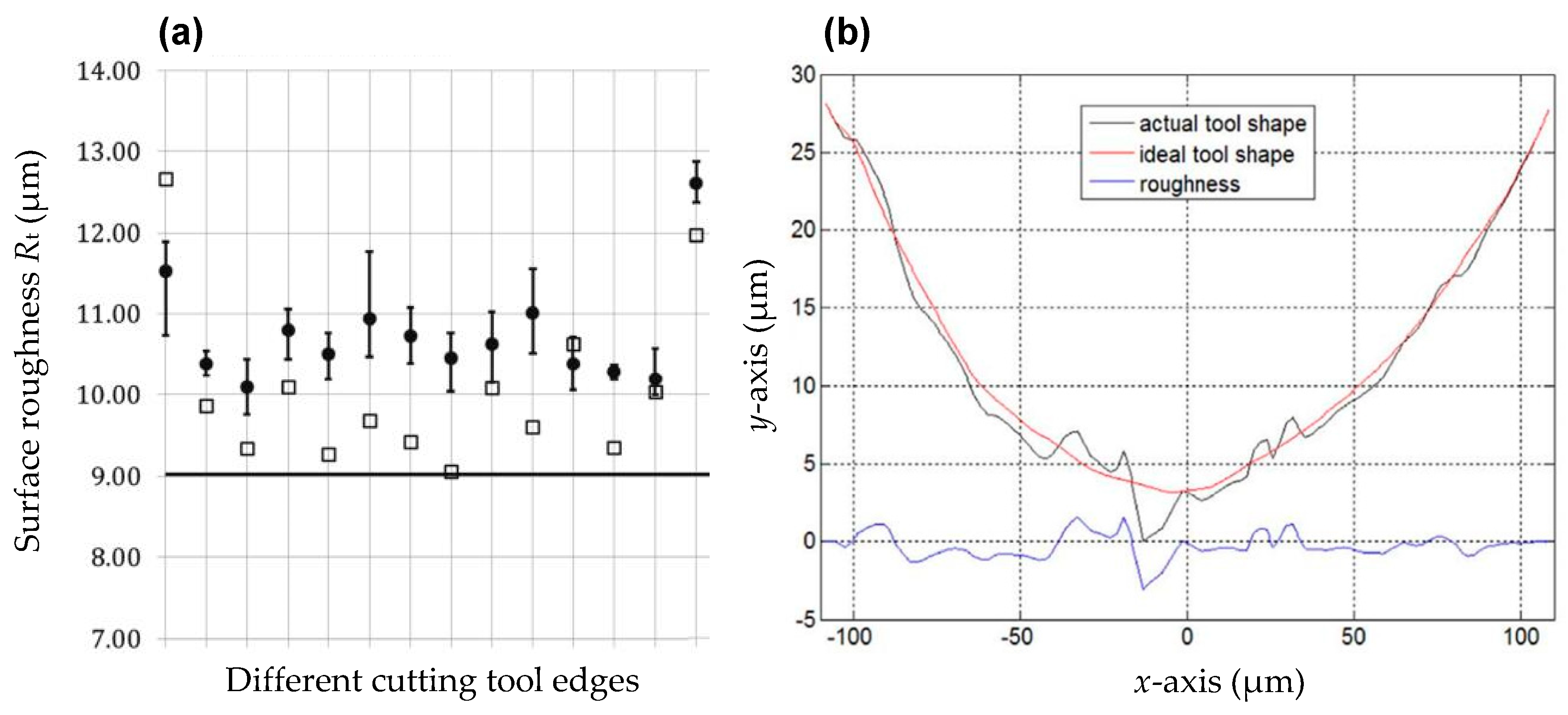
2.2. Surface Topography in the Radial Direction
2.3. 3D Surface Topography for Diamond Turned Component
3. Future Work
4. Conclusions
- (1)
- For the surface profile model corresponding to one feed, in addition to the known factors, such as feed rate per revolution and tool corner nose radius, the tool edge waviness and material dependent factors including the material spring back and material plastic side flow should also be given enough attention. Furthermore, the influence mechanism and the corresponding modeling methods of the other factors, such as depth of cut and spindle speed, are deserved to further clarified and subsequently integrated into the surface topography model.
- (2)
- For the surface topography in the radial direction, the ‘trim principle’ is extensively employed in the calculation of the coordinate values in the height direction. Furthermore, researchers have made great effort on the impact of vibration between diamond tool and workpiece, and the expression of harmonic vibration develops from the mono-frequency vibration to the multi-frequency vibration and multi-direction vibration. Herein, to improve the prediction accuracy, the real-time vibration signal and error components related to machine tool as well as cutting tool are recommended to be cooperated into the future surface topography model.
- (3)
- Defects in the work material matrix have a great impact on the final achieved surface topography in diamond turning process, which is closely associated with work material solidification process. For the single crystal material, the influence of the grain orientation should be further taken into account. For the polycrystalline work material, different experimental results are observed for the aluminium alloy and copper material when considering the grain boundary. Hard particles within the polycrystalline work material are responsible for the scratches and raised structures on the machined surface. Furthermore, influencing factors in relation to the ambient environment and the validation for the prediction accuracy should also be concerned on the surface topography model.
Author Contributions
Funding
Acknowledgments
Conflicts of Interest
Nomenclature
| A | Amplitude of the mono-frequency vibration |
| E | Yong’s modulus of the work material |
| F(x) | Surface profile in one feed rate |
| H | Hardness of the work material |
| Rtew(x) | Surface profile in one feed rate with consideration of tool edge waviness |
| Rtew-wi(x) | Active tool edge profile in one feed rate (without consideration of the tool edge waviness) |
| SP | Average swelling ratio in the radial direction |
| SRi | Local swelling ratio SPi at the ith radial section |
| e | Correct coefficient considering the influence of strain gradient strengthening effect of work material |
| f | Feed rate per revolution |
| fn | Spindle rotation frequency in diamond turning |
| fz | Vibration frequency in diamond turning |
| h | Contact depth in the scratch test |
| ha | Height component induced by the material side flow |
| hDmin | Minimum undeformed chip thickness |
| k | Corresponding linear coefficient in relation to the contact behavior |
| pe | Elastic recovery rate when ploughing/rubbing occurs. |
| rn | Cutting edge radius of diamond tool |
| rz-n | Ratio of the vibration frequency to the spindle rotation frequency |
| rε | Corner nose radius of diamond tool |
| sr | Value of material spring back in the margin position (x =±f/2) in one feed rate |
| tBm | Time points when the diamond tool locates at the point Bm |
| tBM | Time points when the diamond tool locates at the point BM |
| tc | Chip thickness in diamond turning |
| tcmax | Maximum undeformed chip thickness |
| tcmin | Minimum undeformed chip thickness |
| te | Elastic deformation limit of the work material |
| w | Roughness component in relation to the material plastic side flow |
| wr | Value of material plastic side flow in the center (x = 0) in one feed rate |
| zv(t) | Vibration function at the cutting time t |
| Δ | Integer part of the frequency ratio |
| δtc | Distribution model of material spring back |
| ε | Decimal fraction part of the frequency ratio and in the range of -0.5 to 0.5 |
| η | Coefficient in relation to the material spring back |
| θ | Angular coordinate for the point on the workpiece surface |
References
- Shore, P.; Morantz, P. Ultra-precision: enabling our future. Philos. R. Soc. A. Math. Phys. Eng. Sci. 2012, 370, 3993–4014. [Google Scholar] [CrossRef] [PubMed]
- Zong, W.J.; Cao, Z.M.; He, C.L.; Sun, T. Critical undeformed chip thickness of brittle materials in single point diamond turning. Int. J. Adv. Manuf. Technol. 2015, 81, 975–984. [Google Scholar] [CrossRef]
- Zong, W.J.; Cao, Z.M.; He, C.L.; Sun, T. Theoretical modeling and FE simulation on the oblique diamond turning of ZnS crystal. Int. J. Mach. Tools Manuf. 2016, 100, 55–71. [Google Scholar] [CrossRef]
- Li, C.J.; Li, Y.; Gao, X.; Duong, C.V. Ultra-precision machining of Fresnel lens mould by single-point diamond turning based on axis B rotation. Int. J. Adv. Manuf. Technol. 2015, 77, 907–913. [Google Scholar] [CrossRef]
- Zong, W.J.; Cheng, K.; Li, D.; Sun, T.; Liang, Y. The ultimate sharpness of single-crystal diamond cutting tools—Part I: Theoretical analyses and predictions. Int. J. Mach. Tools Manuf. 2007, 47, 852–863. [Google Scholar] [CrossRef]
- Ni, H.; Wang, Y.; Gong, H.; Pan, L.; Li, Z.J.; Wang, D. A novel free-form transducer for the ultra-precision diamond cutting of die steel. Int. J. Adv. Manuf. Technol. 2018, 95, 2185–2192. [Google Scholar] [CrossRef]
- Sun, Z.; To, S.; Yu, K.M. An investigation in the ultra-precision fly cutting of freeform surfaces on brittle materials with high machining efficiency and low tool wear. Int. J. Adv. Manuf. Technol. 2018, 101, 1583–1593. [Google Scholar] [CrossRef]
- Tian, F.; Yin, Z.; Li, S. A novel long range fast tool servo for diamond turning. Int. J. Adv. Manuf. Technol. 2016, 86, 1227–1234. [Google Scholar] [CrossRef]
- Liu, L.; Lu, L.; Gao, Q.; Zhang, R.; Chen, W. External aerodynamic force on an ultra-precision diamond fly-cutting machined for KDP crystal machining. Int. J. Adv. Manuf. Technol. 2017, 93, 4169–4178. [Google Scholar] [CrossRef]
- Feng, H.; Jiang, S. Dynamic analysis of water-lubricated motorized spindle considering tilting effect of thrust bearing. Proc. Inst. Mech. Eng. C J. Mech. Eng. Sci. 2017, 231, 3780–3790. [Google Scholar] [CrossRef]
- Revel, P.; Jouini, N.; Thoquenne, G.; Lefebvre, F. High precision hard turning of AISI 52100 bearing steel. Precis. Eng. 2016, 43, 24–33. [Google Scholar] [CrossRef]
- Weck, M.; McKeown, P.; Bonse, R.; Herbst, U. Reduction and compensation of thermal errors in machine tools. CIRP Ann. 1995, 44, 589–598. [Google Scholar] [CrossRef]
- Mayr, J.; Jedrzejewski, J.; Uhlmann, E.; Donmez, M.A.; Knapp, W.; Härtig, F.; Wendt, K.; Moriwaki, T.; Shore, P.; Schmitt, R.; Brecher, C. Thermal issues in machine tools. CIRP Ann. 2016, 61, 771–791. [Google Scholar] [CrossRef]
- Harvey, J.; Schroder, S.; Choi, N.; Duparre, A. Total integrated scatter from surfaces with arbitrary roughness, correlation widths and incident angles. Opt. Eng. 2012, 51, 013402. [Google Scholar] [CrossRef]
- He, C.L.; Zong, W.J.; Cao, Z.M.; Sun, T. Theoretical and empirical coupled modeling on the surface roughness in diamond turning. Mater. Desi. 2015, 82, 216–222. [Google Scholar] [CrossRef]
- Li, L.; Collins, S.; Allen, Y. Optical effects of surface finish by ultraprecision single point diamond machining. Trans. ASME J. Manuf. Sci. Eng. 2010, 132, 10021–10029. [Google Scholar] [CrossRef]
- Gadelmawla, E.S.; Koura, M.M.; Maksoud, T.M.A.; Elewa, I.M.; Soliman, H.H. Roughness parameters. J. Mater. Process. Technol. 2002, 123, 133–145. [Google Scholar] [CrossRef]
- He, C.L.; Wang, S.J.; Zong, W.J.; Zhang, S.T. Influence of tool edge waviness on the diffraction effect of diamond-turned optics: theoretical simulation and experimental validation. App. Opt. 2019, 58, 1596–1605. [Google Scholar] [CrossRef]
- Zong, W.J.; Huang, Y.; Zhang, Y.; Sun, T. Conservation law of surface roughness in single point diamond turning. Int. J. Mach. Tools Manuf. 2014, 84, 58–63. [Google Scholar] [CrossRef]
- Lee, W.B.; Cheung, C.F.; To, S. Materials induced vibration in ultra-precision machining. J. Mater. Process. Technol. 1999, 89, 318–325. [Google Scholar] [CrossRef]
- Lee, W.B.; Cheung, C.F. A dynamic surface topography model for the prediction of nano-surface generation in ultra-precision machining. Int. J. Mech. Sci. 2001, 43, 961–991. [Google Scholar] [CrossRef]
- Yu, D.; Gan, S.; Wong, Y.; Hong, G.; Rahman, M.; Yao, J. Optimized tool path generation for fast tool servo diamond turning of micro-structured surfaces. Int. J. Adv. Manuf. Technol. 2012, 63, 1137–1152. [Google Scholar] [CrossRef]
- Zong, W.J.; Li, Z.Q.; Sun, T.; Cheng, K.; Li, D.; Dong, S. The basic issues in design and fabrication of diamond-cutting tools for ultra-precision and nanometric machining. Int. J. Mach. Tools Manuf. 2010, 50, 411–419. [Google Scholar] [CrossRef]
- Jang, S.; Shimizu, Y.; Ito, S.; Gao, W. A micro optical probe for edge contour evaluation of diamond cutting tools. J. Sens. Sens. Syst. 2014, 3, 69–76. [Google Scholar] [CrossRef]
- He, C.L.; Zong, W.J.; Sun, T. Origins for the size effect of surface roughness in diamond turning. Int. J. Mach. Tool Manuf. 2016, 106, 22–42. [Google Scholar] [CrossRef]
- Sung, A.N.; Ratnam, M.; Loh, W. Effect of tool nose profile tolerance on surface roughness in finish turning. Int. J. Adv. Manuf. Technol. 2015, 76, 2083–2098. [Google Scholar] [CrossRef]
- Sung, A.N.; Loh, W.P.; Ratnam, M.M. Simulation approach for surface roughness interval prediction in finishing turning. Int. J. Simulat. Model. 2016, 15, 42–55. [Google Scholar] [CrossRef]
- He, C.L.; Zong, W.J.; Xue, C.X.; Sun, T. An accurate 3D surface topography model for single-point diamond turning. Int. J. Mach. Tools Manuf. 2018, 134, 42–68. [Google Scholar] [CrossRef]
- Kurniawan, R.; Kiswanto, G.; Ko, T. Surface roughness of a two-frequency elliptical vibration texturing (TFEVT) method for micro-dimple pattern process. Int. J. Mach. Tools Manuf. 2017, 116, 77–95. [Google Scholar] [CrossRef]
- Zong, W.J.; Li, Z.; Zhang, L.; Liang, Y.; Sun, T.; An, C.H.; Zhang, J.F.; Zhou, L.; Wang, J. Finite element simulation of diamond tool geometries affecting the 3D surface topography in fly cutting of KDP crystals. Int. J. Adv. Manuf. Technol. 2013, 68, 1927–1936. [Google Scholar] [CrossRef]
- Zuo, C.; Zhou, X.; Liu, Q.; Wang, R.; Lin, J.; Xu, P.; Zhang, X. Analytical topography simulation of micro/nano textures generated on freeform surfaces in double-frequency elliptical vibration cutting based on diamond turning. Trans. ASME J. Manuf. Sci. Eng. 2018, 140, 101010. [Google Scholar] [CrossRef]
- Childs, T.H.C.; Sekiya, K.; Tezuka, R.; Yamane, Y.; Dornfeld, D.; Lee, D.E.; Min, S.; Wright, P.K. Surface finishes from turning and facing with round nosed tools. CIRP Ann. 2008, 57, 89–92. [Google Scholar] [CrossRef]
- Childs, T.H.C.; Dornfeld, D.; Lee, D.; Min, S.; Sekiya, K.; Tezuka, R.; Yamane, Y. The influence of cutting edge sharpness on surface finish in facing with round nosed cutting tools. CIRP J. Manuf. Sci. Technol. 2008, 1, 70–75. [Google Scholar] [CrossRef]
- Yuan, Z.J.; Zhou, M.; Dong, S. Effect of diamond tool sharpness on minimum cutting thickness and surface integrity cutting surface integrity in ultraprecision machining. J. Mater. Process. Technol. 1996, 62, 327–330. [Google Scholar] [CrossRef]
- Liu, X.; DeVor, R.E.; Kapoor, S.G. An analytical model for the prediction of minimum chip thickness in micromachining. Trans. ASME J. Manuf. Sci. Eng. 2006, 128, 474–481. [Google Scholar] [CrossRef]
- Ikawa, N.; Shimada, S.; Tanaka, H.; Ohmori, G. An atomistic analysis of nanometric chip removal as affected by tool-work interaction in diamond turning. CIRP Ann. 1991, 40, 551–554. [Google Scholar] [CrossRef]
- Malekian, M.; Mostofa, M.G.; Park, S.S.; Jun, M.B.G. Modeling of minimum uncut chip thickness in micro machining of aluminum. J. Mater. Process. Technol. 2012, 212, 553–559. [Google Scholar] [CrossRef]
- Son, S.M.; Lim, H.S.; Ahn, J.H. Effects of the friction coefficient on the minimum cutting thickness in micro cutting. Int. J. Mach. Tools Manuf. 2005, 45, 529–535. [Google Scholar] [CrossRef]
- Rahman, M.A.; Amrun, M.R.; Rahman, M.; Kumar, A.S. Variation of surface generation mechanisms in ultra-precision machining due to relative sharpness (RTS) and material properties. Int. J. Mach. Tools Manuf. 2017, 115, 15–28. [Google Scholar] [CrossRef]
- He, C.L.; Zong, W.J.; Zhang, J.J. Influencing factors and theoretical modeling methods of surface roughness in turning process: State-of-the-art. Int. J. Mach. Tool Manuf. 2018, 129, 15–26. [Google Scholar] [CrossRef]
- Rahman, M.A.; Rahman, M.; Kumar, A.S. Chip perforation and ‘burnishing-like’ finishing of Al alloy in precision machining. Precis Eng. 2017, 50, 393–409. [Google Scholar] [CrossRef]
- Arcona, C.; Dow, T.A. An empirical tool force model for precision machining. Trans. ASME J. Manuf. Sci. Eng. 1998, 120, 700–707. [Google Scholar] [CrossRef]
- Arcona, C. Tool Force, Chip Formation and Surface Finish in Diamond Turning. Ph.D. Thesis, North Carolina State University, Raleigh, NC, USA, 1996. [Google Scholar]
- Jardret, V.; Zahouani, H.; Loubet, J.L.; Mathia, T.G. Understanding and qualification of elastic and plastic deformation during a scratch test. Wear 1998, 218, 8–14. [Google Scholar] [CrossRef]
- Liu, K.; Melkote, S.N. Effect of plastic side flow on surface roughness in micro-turning process. Int. J. Mach. Tools Manuf. 2006, 46, 1778–1785. [Google Scholar] [CrossRef]
- Liu, K.; Melkote, S.N. Material strengthening mechanisms and their contribution to size effect in micro-cutting. Trans. ASME J. Manuf. Sci. Eng. 2006, 128, 730–738. [Google Scholar] [CrossRef]
- Kong, M.C.; Lee, W.B.; Cheung, C.F.; To, S. A study of material swelling and recovery in single-point diamond turning of ductile materials. J. Mater Process Technol. 2006, 180, 210–215. [Google Scholar] [CrossRef]
- To, S.; Cheung, C.F.; Lee, W.B. Influencing of material swelling on surface roughness in diamond turning of single crystals. Mat. Sci. Technol. 2001, 17, 102–108. [Google Scholar] [CrossRef]
- Yip, W.S.; To, S. Reduction of material swelling and recovery of titanium alloys in diamond cutting by magnetic field assistance. J. Alloy Compd. 2017, 722, 525–531. [Google Scholar] [CrossRef]
- Xu, F.; Fang, F.; Zhang, X. Effects of recovery and side flow on surface generation in nano-cutting of single crystal silicon. Comp. Mater. Sci. 2018, 143, 133–142. [Google Scholar]
- Kishawy, H.A.; Elbestawi, M.A. Effects of process parameters on material side flow during hard turning. Int. J. Mach Tools Manuf. 1999, 39, 1017–1030. [Google Scholar] [CrossRef]
- Kishawy, H.A.; Haglund, A.; Balazinski, M. Modeling of material side flow in hard turning. CIRP Ann. 2006, 55, 85–88. [Google Scholar] [CrossRef]
- Chen, G.; Liu, X.; Wang, L.; Zhou, X. The research and modeling about plastic flow measurement of machined surface in precision turning of hardened steel GCr 15. Int. J. Nanomanuf. 2016, 12, 154–166. [Google Scholar] [CrossRef]
- Chen, G. Research on Stability and mAterial Plastic Side Flow in High Speed Precision Turning Process of Hardened Steel. Ph.D. Thesis, Harbin University of Science and Technology, Harbin, China, 2001. [Google Scholar]
- Zhu, W.L.; Duan, F.; Zhang, X.; Zhu, Z.W.; Ju, B. A new diamond machining approach for extendable fabrication of micro-freeform lens array. Int. J. Mach. Tools Manuf. 2018, 124, 134–148. [Google Scholar] [CrossRef]
- Huang, P.; Lee, W.B. Cutting force prediction for ultra-precision diamond turning by considering the effect of tool edge radius. Int. J. Mach. Tools Manuf. 2016, 109, 1–7. [Google Scholar] [CrossRef]
- Liu, X.; DeVor, R.E.; Kapoor, S.G. Model-based analysis of the surface generation in microend milling-Part I: model development. Trans. ASME J. Manuf. Sci. Eng. 2007, 129, 453–460. [Google Scholar] [CrossRef]
- Guo, P.; Ehmann, K.F. An analysis of the surface generation mechanics of the elliptical vibration texturing process. Int. J. Mach. Tools Manuf. 2013, 64, 85–95. [Google Scholar] [CrossRef]
- Cheung, C.F.; Lee, W.B. A multi-spectrum analysis of surface roughness formation in ultra-precision machining. Precis Eng. 2000, 24, 77–87. [Google Scholar] [CrossRef]
- Chen, J.; Zhao, Q. A model for predicting surface roughness in single-point diamond turning. Measurement 2015, 69, 20–30. [Google Scholar] [CrossRef]
- Xu, F.; Wang, J.; Fang, F.; Zhang, X. A study on the tool edge geometry effect on nano-cutting. Int. J. Adv. Manuf. Technol. 2017, 91, 2787–2797. [Google Scholar] [CrossRef]
- Kurniawan, R.; Ko, T.J. Surface Topography analysis in three-dimensional elliptical vibration texturing (3D-EVT). Int. J. Adv. Manuf. Technol. 2019, 1–21. [Google Scholar] [CrossRef]
- Zhou, L.; Cheng, K. Dynamic cutting process modeling and its impact on the generation of surface topography and texture in nano/micro cutting. Proc. Inst. Mech. Eng. Part B J. Eng. Manuf. 2009, 223, 247–266. [Google Scholar] [CrossRef]
- Zhang, C.; Shi, G.; Ehmann, K.F.; Li, Y. Modeling and simulation of micro-groove topography on cylindrical surface by elliptical vibration-assisted turning. Int. J. Adv. Manuf. Technol. 2016, 86, 1407–1424. [Google Scholar] [CrossRef]
- Sajjady, S.; Abadi, H.; Amini, S.; Nosouhi, R. Analytical and experimental study of topography of surface texture in ultrasonic vibration assisted turning. Mater. Desi. 2016, 93, 311–323. [Google Scholar] [CrossRef]
- Zhang, S.; To, S.; Zhang, G.; Zhu, Z.W. A review of machine-tool vibration and its influence upon surface generation in ultra-precision machining. Int. J. Mach. Tools Manuf. 2015, 91, 34–42. [Google Scholar] [CrossRef]
- Zhang, S.; To, S.; Wang, S.; Zhu, Z. A review of surface roughness generation in ultra-precision machining. Int. J. Mach. Tools. Manuf. 2015, 91, 76–95. [Google Scholar] [CrossRef]
- Sata, T.; Li, M.; Takata, S.; Hiraoka, H.; Li, C.; Xing, X.; Xiao, X. Analysis of surface roughness generation in turning operation and its application. CIRP Ann. 1985, 34, 473–476. [Google Scholar] [CrossRef]
- Cheung, C.F.; Lee, W.B. Characterisation of nanosurface generation in single point diamond turning. Int. J. Mach. Tools Manuf. 2001, 41, 851–875. [Google Scholar] [CrossRef]
- Takasu, S.; Masuda, M.; Nishiguchi, T. Influence of study vibration with small amplitude upon surface roughness in diamond turning. CIRP Ann. 1985, 34, 463–467. [Google Scholar] [CrossRef]
- Cheung, C.F.; Lee, W.B. Modeling and simulation of surface topography in ultra-precision diamond turning. Proc. Inst. Mech. Eng. Part B J. Eng. Manuf. 2000, 214, 464–480. [Google Scholar] [CrossRef]
- Fawcett, S. Small amplitude vibration compensation for precision diamond turning. Precis. Eng. 1990, 12, 91–96. [Google Scholar] [CrossRef]
- Yang, J.; Wang, X.S.; Kang, M. Finite element simulation of surface roughness in diamond turning of spherical surfaces. J. Manuf. Process. 2018, 31, 768–775. [Google Scholar] [CrossRef]
- Cheung, C.F.; Lee, W.B. Prediction of the effect of tool interference on surface generation in single-point diamond turning. Int. J. Adv. Manuf. Technol. 2002, 19, 245–252. [Google Scholar] [CrossRef]
- Kim, D.; Chang, I.; Kim, S. Microscopic topographical analysis of tool vibration effects on diamond turned optical surfaces. Precis. Eng. 2002, 26, 168–174. [Google Scholar] [CrossRef]
- Tauhiduzzaman, M.; Yip, A.; Veldhuis, S. Form error in diamond turning. Precis. Eng. 2015, 42, 22–36. [Google Scholar] [CrossRef]
- Zhang, S.; To, S. Spindle vibration influencing form error in ultra-precision diamond machining. Proc. Inst. Mech. Eng. Part B. J. Eng. Manuf. 2015, 231, 3144–3151. [Google Scholar] [CrossRef]
- Khanfir, H.; Bonis, M.; Revel, P. Improving waviness in ultra precision turning by optimizing the dynamic behavior of a spindle with magnetic bearings. Int. J. Mach. Tools Manuf. 2005, 45, 841–848. [Google Scholar] [CrossRef]
- Zhang, S.; Yu, J.; To, S.; Xiong, Z. A theoretical and experimental study of spindle imbalance induced forced vibration and its effect on surface generation in diamond turning. Int. J. Mach. Tools Manuf. 2018, 133, 61–71. [Google Scholar] [CrossRef]
- Zhang, S.; To, S.; Wang, H. A theoretical and experimental investigation into five-DOF dynamic characteristic of an aerostatic bearing spindle in ultra-precision diamond turning. Int. J. Mach. Tools Manuf. 2013, 71, 1–10. [Google Scholar] [CrossRef]
- Dong, Z.; Zhang, S.; Xiong, Z.; Rao, X. A generalized dynamic model for spindle vibration influencing surface topography in different ultra-precision machining processes. Int. J. Adv. Manuf. Technol. 2018, 96, 2471–2478. [Google Scholar] [CrossRef]
- Zhang, S.; To, S.; Cheung, C.F.; Wang, H. Dynamic characteristics of an aerostatic bearing spindle and its influence on surface topography in ultra-precision diamond turning. Int. J. Mach. Tools Manuf. 2012, 62, 1–12. [Google Scholar] [CrossRef]
- Tian, F.; Yin, Z.; Li, S. Theoretical and experimental investigation on modeling of surface topography influenced by the tool-workpiece vibration in the turning direction and feeding direction in single-point diamond turning. Int. J. Adv. Manuf. Technol. 2016, 86, 2433–2439. [Google Scholar] [CrossRef]
- Huang, C.; Liang, R. Modeling of surface topography in single-point diamond turning machine. Appl. Optics. 2015, 54, 6979–6985. [Google Scholar] [CrossRef] [PubMed]
- Huang, C.; Liang, R. Modeling of surface topography on diamond turned spherical and freeform surfaces. Appl. Optics. 2017, 56, 4466–4473. [Google Scholar] [CrossRef] [PubMed]
- Lin, Z.; Wang, S.; Chen, X.; To, S.; Yin, Z.; Liu, J. Modeling and prediction of surface topography with three tool-work vibration components in single-point diamond turning. Int. J. Adv. Manuf. Technol. 2018, 98, 1627–1639. [Google Scholar]
- Qu, D.; Zhang, P.; Qiao, Z.; Wu, D.; Wang, B. A simulation model for predicting three-dimensional morphology in ultra-precision roll die turning. Int. J. Adv. Manuf. Technol. 2016, 86, 681–689. [Google Scholar] [CrossRef]
- Chen, W.; Sun, Y.; An, C.; Su, H.; Yang, K.; Zhang, Q. Modeling and simulation of the interaction of manufacturing process and machine tool structure in flycutting machining. Proc. Inst. Mech. Eng. Part C. J. Mech. Eng. Sci. 2015, 229, 2730–2736. [Google Scholar] [CrossRef]
- Chen, W.; Lu, L.; Yang, K.; Su, H.; Chen, G. An experimental and theoretical investigation into multimode machine tool vibration with surface generation in flycutting. Proc. Inst. Mech. Eng. Part B. J. Eng. Manuf. 2016, 230, 381–386. [Google Scholar] [CrossRef]
- Chen, W.; Liu, H.; Sun, Y.; Yang, K.; Zhang, J. A novel simulation method for interaction of machining process and machine tool structure. Int. J. Adv. Manuf. Technol. 2017, 88, 3467–3474. [Google Scholar] [CrossRef]
- Gao, Q.; Lu, L.; Cen, W.; Wang, G. The influence of oil source pressure fluctuation on the waviness error of potassium dihydrogen phosphate in ultra-precision machining. Proc. Inst. Mech. Eng. Part B. J. Eng. Manuf. 2019, 233, 486–493. [Google Scholar] [CrossRef]
- Gao, Q.; Lu, L.; Chen, W.; Wang, G. Influence of air-induced vibration of aerostatic bearing on the machined surface quality in ultra-precision flycutting. Proc. Inst. Mech. Eng. Part B. J. Eng. Manuf. 2018, 232, 117–125. [Google Scholar] [CrossRef]
- Kong, L.B.; Cheung, C.F.; Twok, T. Theoretical and experimental analysis of the effect of error motions on surface generation in fast tool servo machining. Precis. Eng. 2014, 38, 428–438. [Google Scholar] [CrossRef]
- Yang, J.; Guan, J.; Ye, X.; Li, B.; Cao, Y. Effects of geometric and spindle errors on the quality of end turning surface. J. Zhejiang Univ-Sci. A. (Appl. Phys. Eng.). 2015, 16, 371–386. [Google Scholar] [CrossRef]
- Bittner, R. Tolerance of single point diamond turned diffractive optical elements and optical surfaces. J. Eur. Opt. Soc-Rapid. Pub. 2007, 2, 07028. [Google Scholar] [CrossRef]
- Wu, Q.; Sun, Y.; Chen, W.; Chen, G. Theoretical and experimental investigation of spindle axial drift and its effect on surface topography in ultra-precision diamond turning. Int. J. Mach. Tools. Manuf. 2017, 116, 107–113. [Google Scholar] [CrossRef]
- Yuan, J.; Lee, W.B.; Yao, X.; Zhou, M. Effect of crystallographic orientation on cutting forces and surface quality in diamond cutting of single crystal. CIRP Ann. 1994, 43, 39–42. [Google Scholar] [CrossRef]
- To, S.; Lee, W.B.; Chan, C.Y. Ultraprecision diamond turning of aluminium single crystals. J. Mat. Process. Technol. 1997, 63, 157–162. [Google Scholar] [CrossRef]
- Chen, H.; Dai, Y.; Zheng, Z.; Gao, H.; Li, X. Effect of crystallographic orientation on cutting forces and surface finish in ductile cutting of KDP crystals. Machining. Sci. Technol. 2011, 15, 231–242. [Google Scholar]
- Komanduri, R.; Chandrasekaran, N.; Raff, M.M.D. simulation of nanometric cutting of single crystal aluminium-effect of crystallographic orientation and direction of cutting. Wear 2000, 242, 60–88. [Google Scholar] [CrossRef]
- Komanduri, R.; Chandrasekaran, N.; Raff, M. Orientation effects in nanometric cutting of single crystal materials: an MD simulation approach. CIRP Ann. 1999, 48, 67–72. [Google Scholar] [CrossRef]
- Li, J.; Fang, Q.; Liu, B. The effects of pore and second-phase particle on the mechanical properties of machining copper matrix from molecular dynamics simulation. App. Surf. Sci. 2016, 384, 419–431. [Google Scholar] [CrossRef]
- Liu, B.; Fang, F.; Liu, R.; Xu, Z.; Liang, Y. Experimental study on size effect of tool edge and subsurface damage on single crystal silicon in nano-cutting. Int. J. Adv. Manuf. Technol. 2018, 98, 1093–1101. [Google Scholar] [CrossRef]
- Moriwaki, T. Machinability of copper in ultra-precision micro diamond cutting. CIRP Ann. Manuf. Technol. 1989, 38, 115–118. [Google Scholar] [CrossRef]
- Inamura, T.; Takezawa, N.; Taniguchi, N. Atomic-scale cutting in a computer using crystal models of copper and diamond. CIRP Ann. 1992, 41, 121–124. [Google Scholar] [CrossRef]
- Brinksmeier, E.; Preuss, W. Micro-machining. Phil. Trans. R. Soc. A. 2012, 370, 3973–3992. [Google Scholar] [CrossRef]
- Brinksmeier, E.; Preuss, W.; Riemer, O.; Rentsch, R. Cutting force, tool wear and surface finish in high speed diamond machining. Precis. Eng. 2017, 49, 293–304. [Google Scholar] [CrossRef]
- Liu, D.; Wang, G.; Yu, J.; Rong, Y. Molecular dynamics simulation on formation mechanism of grain boundary steps in micro-cutting of polycrystalline copper. Comp. Mater. Sci. 2017, 126, 418–425. [Google Scholar] [CrossRef]
- Zhang, X.; Zhang, Y. Study on the surface quality of a diamond turned oxygen-free high-conductance copper reflector used in a high-power CO2 laser. Opt. Eng. 1997, 36, 825–830. [Google Scholar] [CrossRef]
- Ge, F.; Xu, H.; Yang, H.; Luo, B.; Fu, C. Workpiece surface quality when ultra-precision turning of SiCp/Al composites. J. Mater. Process. Technol. 2008, 203, 166–175. [Google Scholar] [CrossRef]
- Tauhiduzzaman, M.; Veldhuis, C. Effect of material microstructure and tool geometry on surface generation in single point diamond turning. Precis. Eng. 2014, 38, 481–491. [Google Scholar] [CrossRef]
- Han, J.D.; Li, L.H.; Chan, C.Y.; Lee, W.B. Investigation on the formation of surface defects of OFHC copper in diamond micro-grooving process. Int. J. Adv.Manuf. Technol. 2017, 93, 4133–4141. [Google Scholar] [CrossRef]
- Ding, X.; Rahman, M. A study of the performance of cutting polycrystalline Al 6061 T6 with single crystalline diamond micro-tools. Precis. Eng. 2012, 36, 593–603. [Google Scholar] [CrossRef]
- Ding, X.; Jarfors, W.; Lim, C.; Shaw, C.; Liu, C.; Tang, J. A study of the cutting performance of poly-crystalline oxygen free copper with single crystalline diamond micro-tools. Precis. Eng. 2012, 36, 141–152. [Google Scholar] [CrossRef]
- Ding, X.; Lee, C.; Butler, L.; Cheng, K. The effects of hard particles on the surface quality when micro-cutting aluminium Al 6061 T6. J. Micromech. Microeng. 2009, 19, 115013. [Google Scholar] [CrossRef]
- Xu, F.; Fang, F.; Zhang, X. Hard particle effect on surface generation in nano-cutting. Appl. Surf. Sci. 2017, 425, 1020–1027. [Google Scholar] [CrossRef]
- Sharma, A.; Datta, D.; Balasubramaniam, R. An investigation of tool and hard particle interaction in nano scale cutting of copper beryllium. Comp. Mat. Sci. 2018, 145, 208–223. [Google Scholar] [CrossRef]
- Mishra, V.; Khatri, N.; Nand, K.; Singh, K.; Sarepaka, V. Experimental investigation on uncontrollable parameters for surface finish during diamond turning. Mat. Manuf. Process. 2015, 30, 223–240. [Google Scholar] [CrossRef]
- Mishra, V.; Khan, S.; Chattopadhyay, D.; Nand, K.; Sarepaka, V. Effects of tool overhang on selection of machining parameters and surface finish during diamond turning. Measurement 2014, 55, 353–361. [Google Scholar] [CrossRef]
- Mir, A.; Luo, X.; Cheng, K.; Cox, A. Investigation of the influence of rake angle in single point diamond turning of silicon. Int. J. Adv. Manuf. Technol. 2018, 94, 2343–2355. [Google Scholar] [CrossRef]
- Adler, D.P.; Hii, W.W.S.; Michalek, D.J.; Sutherland, J.W. Examining the role of cutting fluids in machining and efforts to address associated environmental/health concerns. Mach. Sci. Technol. 2006, 10, 23–58. [Google Scholar] [CrossRef]
- Born, K.; Goodman, A. An empirical survey on the influence of machining parameters on tool wear in diamond turning of large single-crystal silicon optics. Precis. Eng. 2001, 25, 247–257. [Google Scholar] [CrossRef]
- Yildiz, Y.; Nalbant, M. A review of cryogenic cooling in machining processes. Int. J. Mach. Tools Manuf. 2008, 48, 947–964. [Google Scholar] [CrossRef]
- Goel, S.; Luo, X.; Reuben, L.; Pen, H. Influence of temperature and crystal orientation on tool wear during single point diamond turning. Wear 2012, 284, 65–72. [Google Scholar] [CrossRef]
- Cheung, C.F.; Lee, W.B. Study of factors affecting the surface quality in ultra-precision diamond turning. Mater. Manuf. Process. 2000, 15, 481–502. [Google Scholar] [CrossRef]
- Zhang, J.; To, S.; Cheung, C.F.; Zhu, H. Micro-structural changes of Zn-Al alloy influencing micro-topographical surface in micro-cutting. Int. J. Adv. Manuf. Technol. 2014, 72, 9–15. [Google Scholar] [CrossRef]
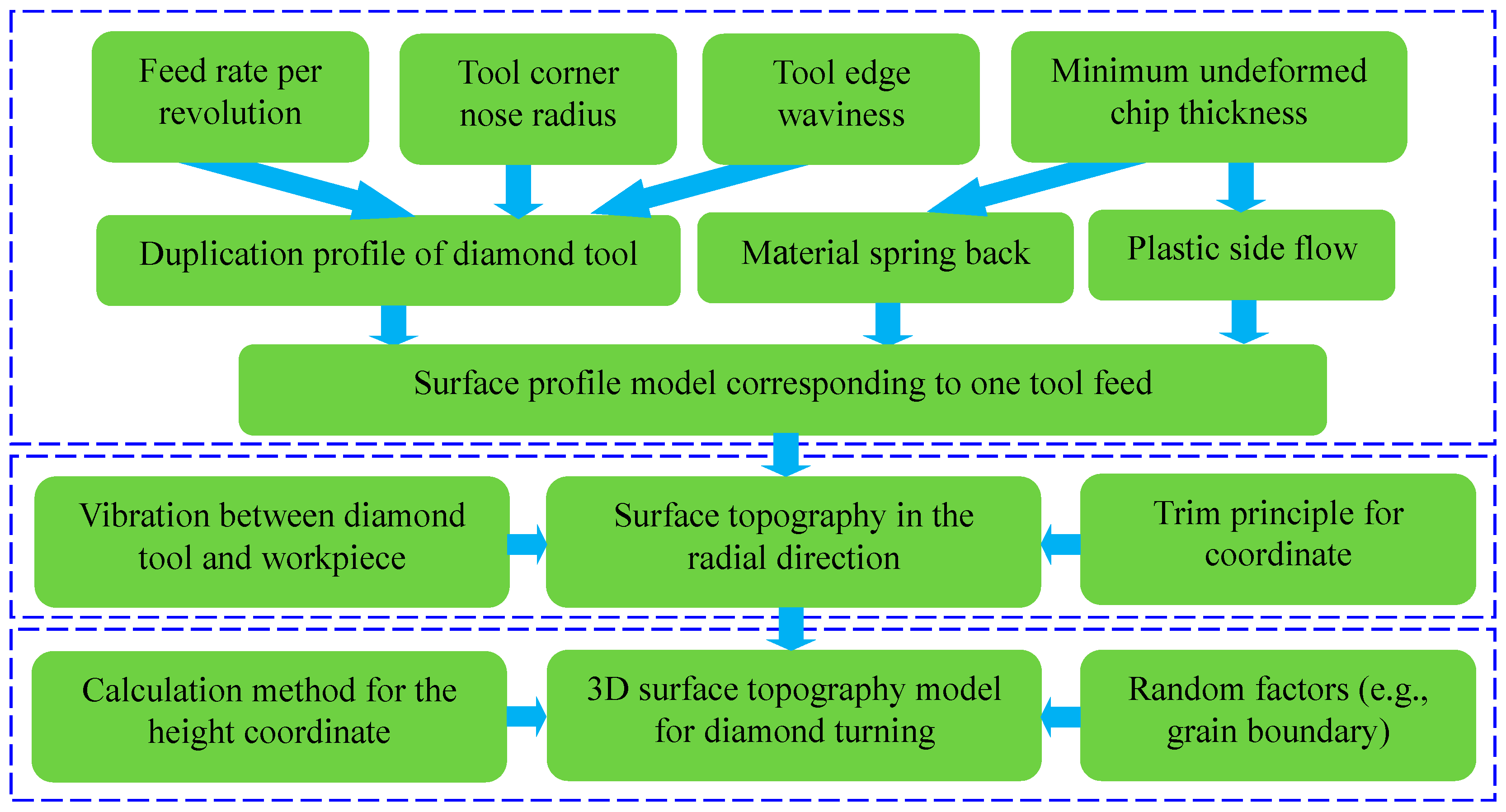
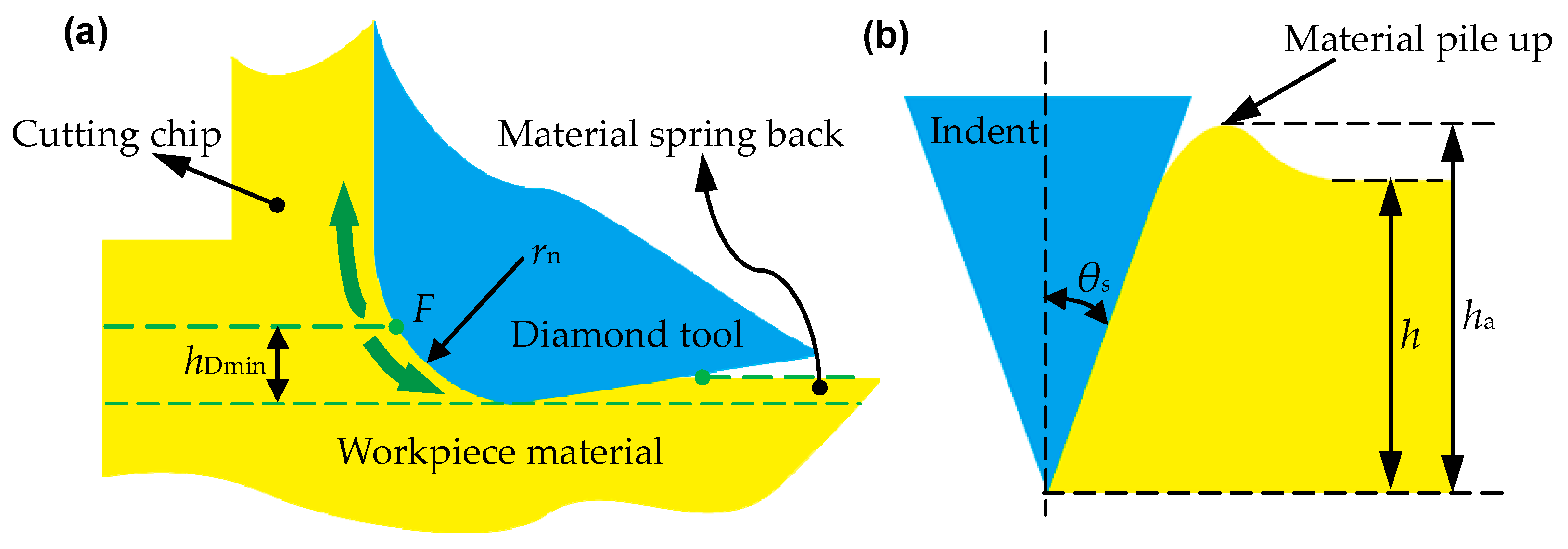
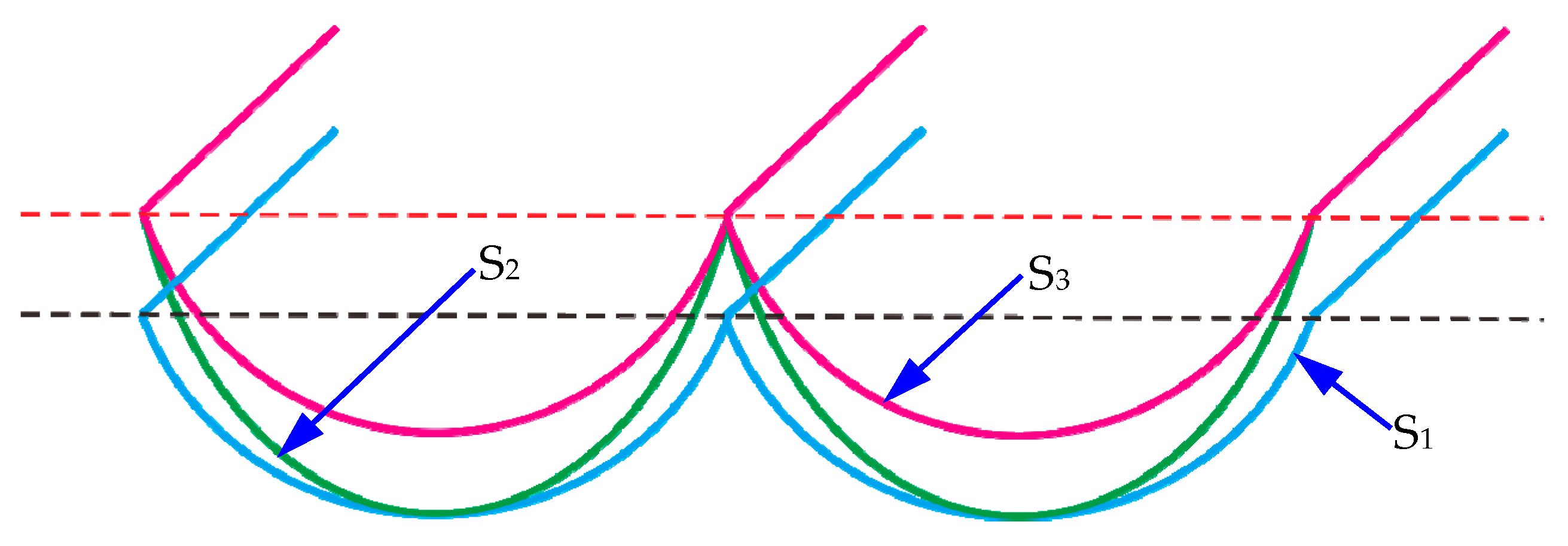

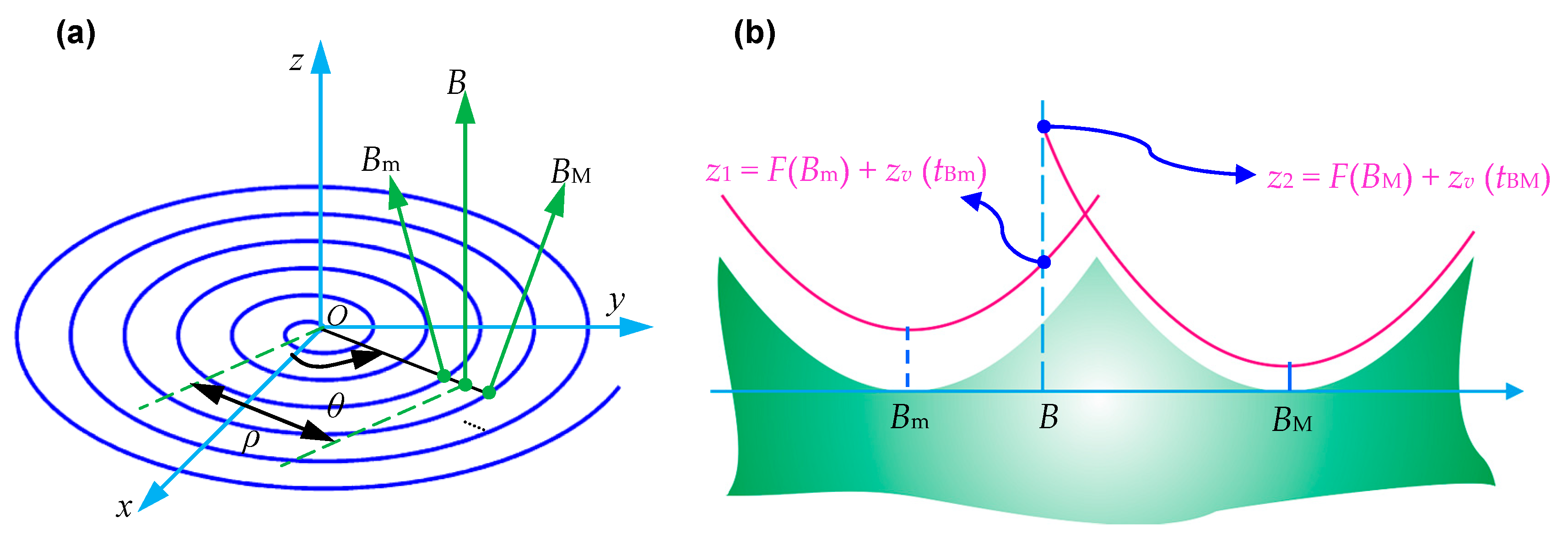
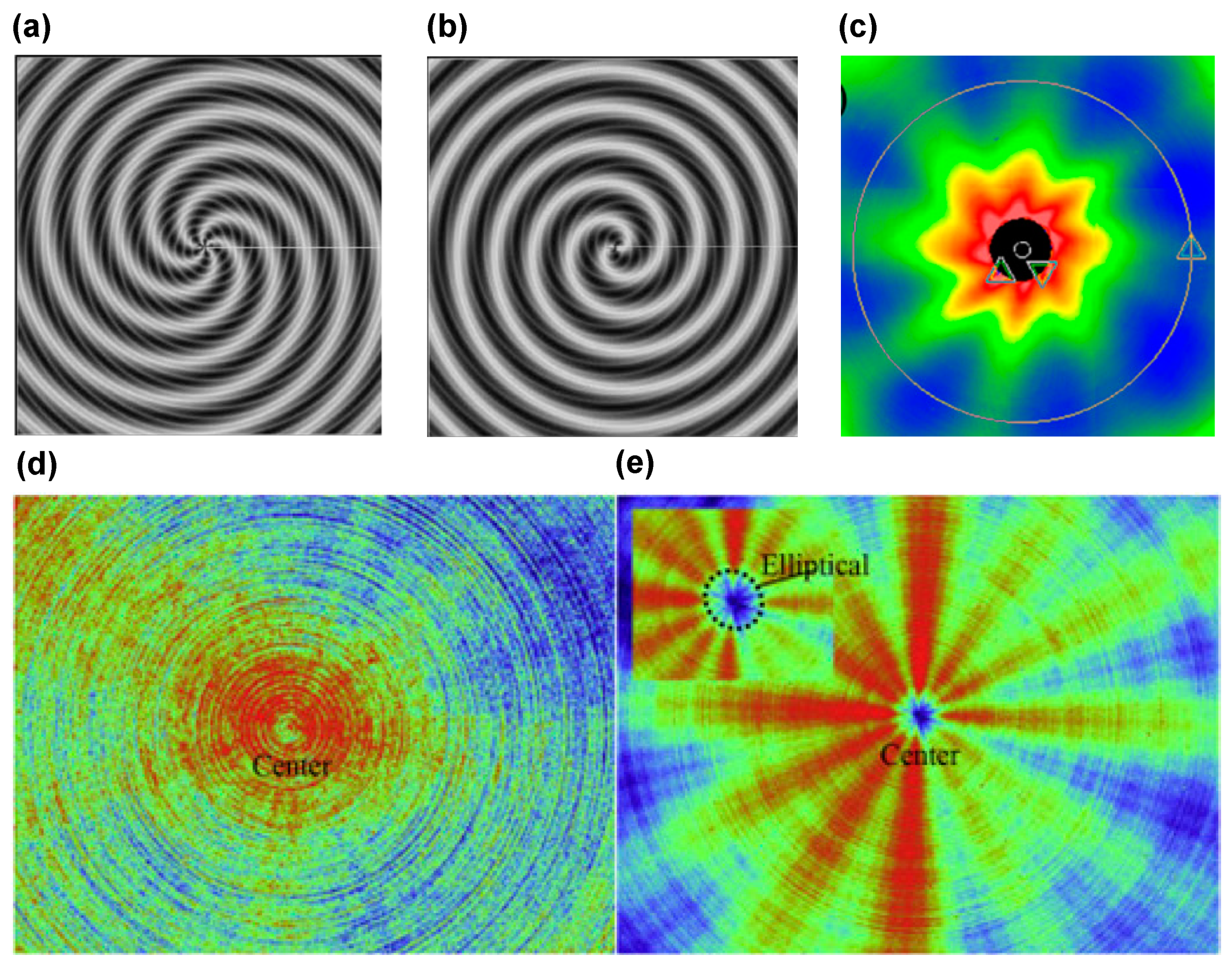
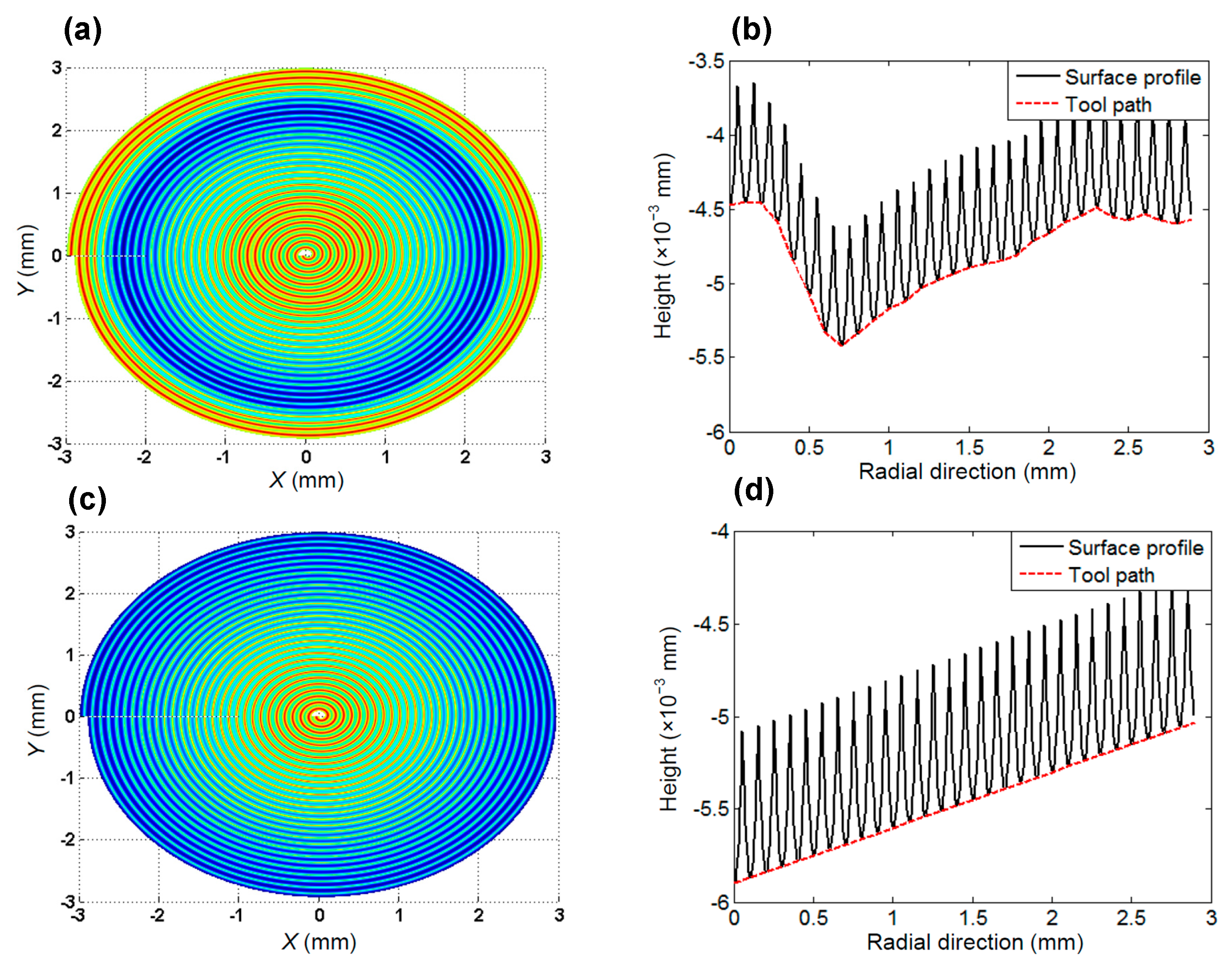
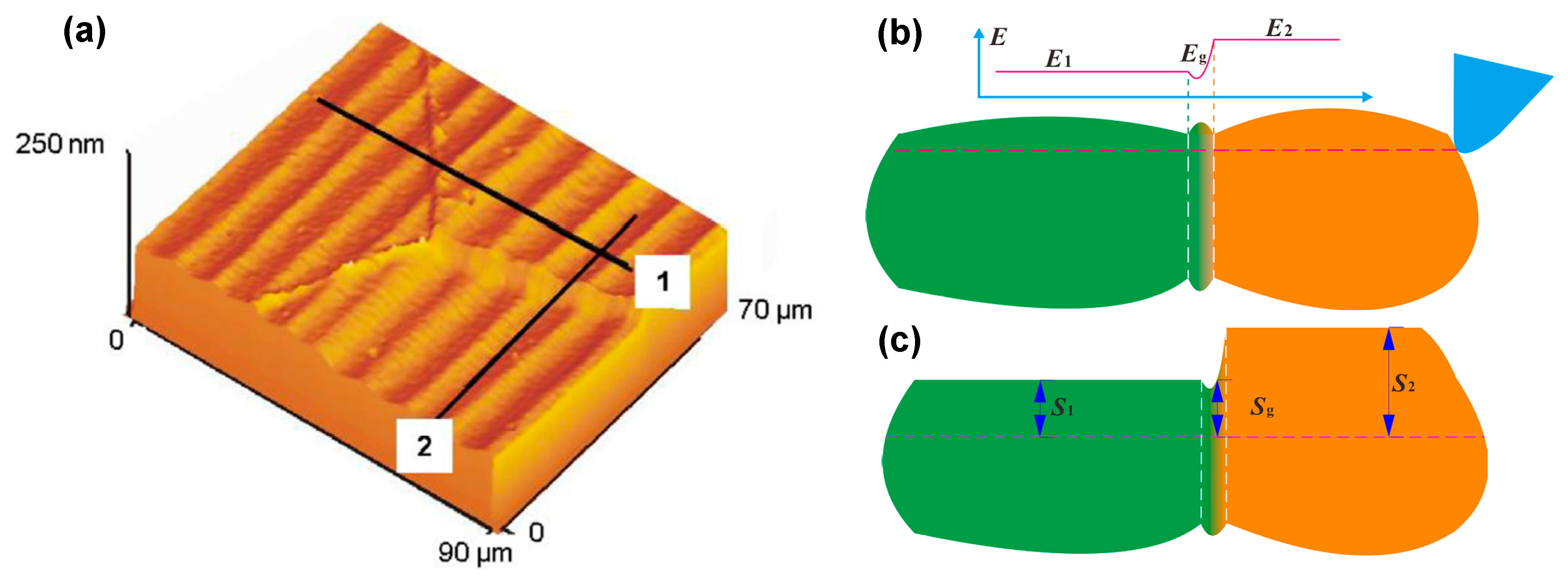
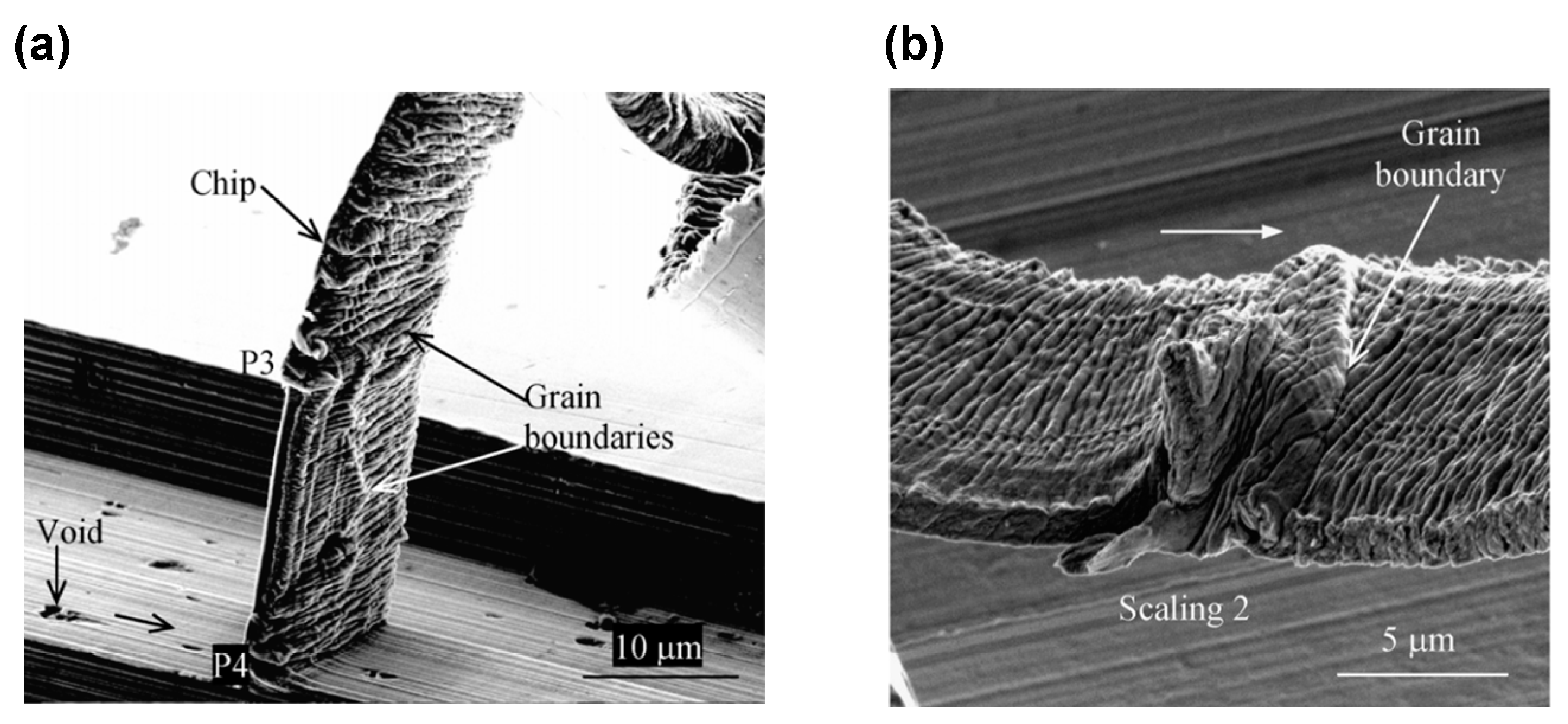

| Authors | Expression | Illustration |
|---|---|---|
| He et al. [28] | wr and sr are the values of material plastic side flow and material spring back, respectively. | |
| Zhu et al. [55] | te is the elastic deformation limit of the work material; tc is the chip thickness and hDmin is the minimum undeformed chip thickness. | |
| Huang et al. [56] | tcmax and tcmin are the maximum and minimum undeformed chip thickness, i.e. tcmin = hDmin. | |
| Liu et al. [57] | pe is the elastic recovery rate when ploughing/rubbing occurs. | |
| Guo et al. [58] | pe is the elastic recovery rate of the work material; η is the corresponding linear coefficient and determined by tcmax, tcmin and pe. | |
| Chen et al. [60] | SP is the swelling ratio. |
| Authors | Expression | Illustration for the ∅ |
|---|---|---|
| Yang et al. [73] | ∅ is the original phase of the vibration and its value is configured as the phase shift between two adjacent vibrations. | |
| He et al. [28] | ∅k is the original phase of the kth vibration and its value comes from the actual measurement | |
| Tian et al. [83] | ∅x and ∅z are assumed to be zero in the modelling process | |
| Huang et al. [84] | ∅x and ∅z are assumed to be zero in the modelling process | |
| Lin et al. [87] | ∅x, ∅y and ∅z are assumed to be zero in the modelling process |
© 2019 by the authors. Licensee MDPI, Basel, Switzerland. This article is an open access article distributed under the terms and conditions of the Creative Commons Attribution (CC BY) license (http://creativecommons.org/licenses/by/4.0/).
Share and Cite
He, C.; Zong, W. Influencing Factors and Theoretical Models for the Surface Topography in Diamond Turning Process: A Review. Micromachines 2019, 10, 288. https://doi.org/10.3390/mi10050288
He C, Zong W. Influencing Factors and Theoretical Models for the Surface Topography in Diamond Turning Process: A Review. Micromachines. 2019; 10(5):288. https://doi.org/10.3390/mi10050288
Chicago/Turabian StyleHe, Chunlei, and Wenjun Zong. 2019. "Influencing Factors and Theoretical Models for the Surface Topography in Diamond Turning Process: A Review" Micromachines 10, no. 5: 288. https://doi.org/10.3390/mi10050288
APA StyleHe, C., & Zong, W. (2019). Influencing Factors and Theoretical Models for the Surface Topography in Diamond Turning Process: A Review. Micromachines, 10(5), 288. https://doi.org/10.3390/mi10050288






